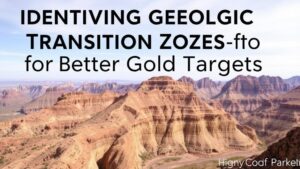Using Geochemical Anomalies to Locate Silver-Bearing Zones
Using Geochemical Anomalies to Locate Silver-Bearing Zones
In the field of mineral exploration, geochemical anomalies serve as critical indicators for locating economically significant deposits, particularly silver-bearing zones. This article delves into the methodologies utilized in identifying these anomalies, the underlying geological principles, and their practical applications in resource exploration.
Understanding Geochemical Anomalies
Geochemical anomalies refer to concentrations of certain elements that deviate significantly from the norm in a given geological setting. These anomalies can result from various geological processes, including hydrothermal activity, weathering, and sedimentary processes.
Silver (Ag) anomalies are typically identified through soil, rock, or sediment sampling, which reveals elevated concentrations of silver compared to the surrounding environment. For example, a silver concentration of more than 1 part per million (ppm) in soil samples may indicate proximity to silver-bearing mineralization.
Methods for Detecting Geochemical Anomalies
Several methods are employed to detect geochemical anomalies effectively:
- Soil Sampling: Collecting soil samples at regular intervals can uncover variations in elemental composition. Testing these samples for silver and related trace elements can help identify potential deposits.
- Rock Chip Sampling: Analyzing outcropping rocks characterized by high silver content can yield immediate evidence of mineralization.
- Stream Sediment Sampling: This method involves analyzing sediment in nearby water bodies for transported silver particles, which might indicate upstream deposits.
Geochemical Indicators of Silver Deposits
Also to tracking silver concentrations, geologists look for accompanying geochemical indicators. Elements such as lead (Pb), zinc (Zn), and copper (Cu) often correlate with silver deposition due to their shared geological environments. For example, the presence of high concentrations of lead and zinc alongside silver may suggest the existence of a polymetallic deposit, commonly found in such geological settings.
Case Studies of Successful Anomaly Detection
Several noteworthy case studies illustrate the successful application of geochemical anomaly detection in locating silver deposits:
- Palace Project, USA: In this project, soil sampling identified zones with silver concentrations exceeding 10 ppm, leading to further exploration and the discovery of an economically viable deposit.
- Escalones Project, Chile: Through stream sediment sampling, geologists detected significant silver presence, prompting extensive drilling campaigns that confirmed substantial mineralization.
Limitations and Challenges
While detecting geochemical anomalies is incredibly useful, explorers face several challenges:
- False Positives: High concentrations of elements can derive from non-economic sources, misleading exploration efforts.
- Environmental Impact: Sampling in sensitive areas may have ecological consequences, necessitating careful planning and execution.
Real-World Applications in Resource Exploration
Identifying silver-bearing zones using geochemical anomalies finds extensive application in the mining industry. Companies can utilize these methods to:
- Optimize exploration budgets by focusing resources on high-potential areas.
- Reduce environmental footprints through targeted exploration.
- Improve recovery rates of silver through better understanding of the ore body.
Actionable Takeaways
To wrap up, the application of geochemical anomalies in locating silver-bearing zones is a powerful tool in modern mineral exploration. By utilizing various sampling methods and recognizing the associated geochemical indicators, explorers can maximize their chances of discovering viable silver deposits. But, it is essential to balance these activities with environmental considerations to ensure sustainable exploration practices.

